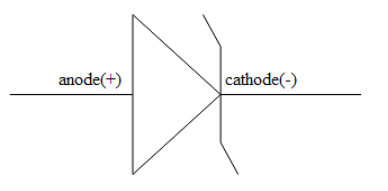
In a zener diode, the reverse bias voltage is $3V$ and the width of the depletion region is $300\overset{0}{\mathop{A}}\,$, the electric field intensity will be ………..$\dfrac{V}{m}$
$\begin{align}
& A{{.10}^{6}} \\
& B{{.10}^{4}} \\
& C{{.10}^{8}} \\
& D{{.10}^{-2}} \\
\end{align}$
Answer
572.7k+ views
Hint: A zener diode is a semiconductor equipment which is made up of silicon. It will allow current to flow in either a forward or reverse direction. This type of diode is made up of a heavily doped p-n junction which is developed due to the conduction occurring in the reverse direction when a particular voltage has been reached. In this the magnitude of the barrier electric field for a zener diode can be found by dividing the reverse bias voltage with the width of the depletion region. These details may help you to solve this question.
Formula Used:
$E=\dfrac{V}{d}$
Complete step-by-step answer:
First of all let us take a look at the value which are mentioned in the question,
The reverse bias voltage of the given zener diode is given as,
$V=3V$
The width of the depletion region in this zener diode has been mentioned as,
$d=300\times {{10}^{-10}}m$
Therefore as we all know, the magnitude of the barrier electric field can be found as,
$E=\dfrac{V}{d}$
Substituting the given values in it,
$E=\dfrac{3V}{300\times {{10}^{-10}}}={{10}^{8}}\dfrac{V}{m}$
This has been mentioned as the third option in the question. Therefore the correct answer is option C.

Note: Zener diodes are helpful in voltage regulation. It is used as the reference elements, surge suppressors, and also in switching applications and clipper circuits. The resistor which is connected in series limits the current flow through the diode and it will reduce the extra voltage if the diode is conducting. The zener diodes are made as reverse biased diodes which can actually operate in a breakdown. When the reverse bias voltage increases, Zener diodes will continue to conduct a fixed amount of current known as the saturation current. This happens only up to the reach of a certain voltage.
Formula Used:
$E=\dfrac{V}{d}$
Complete step-by-step answer:
First of all let us take a look at the value which are mentioned in the question,
The reverse bias voltage of the given zener diode is given as,
$V=3V$
The width of the depletion region in this zener diode has been mentioned as,
$d=300\times {{10}^{-10}}m$
Therefore as we all know, the magnitude of the barrier electric field can be found as,
$E=\dfrac{V}{d}$
Substituting the given values in it,
$E=\dfrac{3V}{300\times {{10}^{-10}}}={{10}^{8}}\dfrac{V}{m}$
This has been mentioned as the third option in the question. Therefore the correct answer is option C.

Note: Zener diodes are helpful in voltage regulation. It is used as the reference elements, surge suppressors, and also in switching applications and clipper circuits. The resistor which is connected in series limits the current flow through the diode and it will reduce the extra voltage if the diode is conducting. The zener diodes are made as reverse biased diodes which can actually operate in a breakdown. When the reverse bias voltage increases, Zener diodes will continue to conduct a fixed amount of current known as the saturation current. This happens only up to the reach of a certain voltage.
Recently Updated Pages
A man running at a speed 5 ms is viewed in the side class 12 physics CBSE

The number of solutions in x in 02pi for which sqrt class 12 maths CBSE

State and explain Hardy Weinbergs Principle class 12 biology CBSE

Write any two methods of preparation of phenol Give class 12 chemistry CBSE

Which of the following statements is wrong a Amnion class 12 biology CBSE

Differentiate between action potential and resting class 12 biology CBSE

Trending doubts
What are the major means of transport Explain each class 12 social science CBSE

Which are the Top 10 Largest Countries of the World?

Draw a labelled sketch of the human eye class 12 physics CBSE

Explain sex determination in humans with line diag class 12 biology CBSE

Explain sex determination in humans with the help of class 12 biology CBSE

Differentiate between homogeneous and heterogeneous class 12 chemistry CBSE




